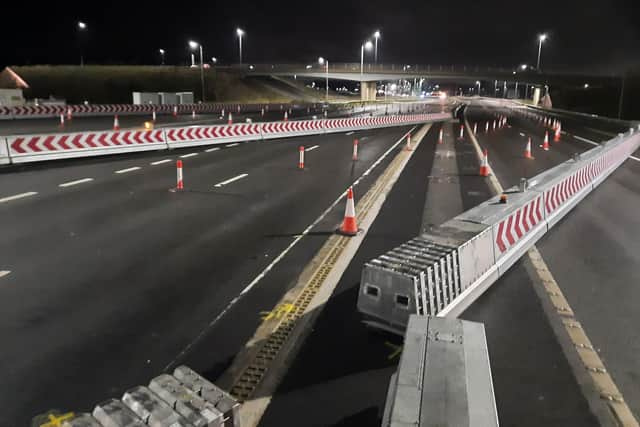Barriers at Queensferry Crossing are a first for the UK
and live on Freeview channel 276
The barriers, manufactured by SPIE in the Netherlands, are the first of their kind to be used in the UK. At the Queensferry Crossing, the system comprises of eight barriers that move themselves across the carriageway at the touch of a button to redirect the M90 motorway directly onto the Forth Road Bridge, removing the need for most of the manual work that was previously required.
In the first full trial deployment on Sunday, November 5, M90 traffic was running over the Forth Road Bridge just 38 minutes after all traffic on the approaches to the Queensferry Crossing had been stopped. Previously, it took up to six hours to manually erect the traffic management required for such a diversion.
Advertisement
Hide AdAdvertisement
Hide AdWorks are planned in 2024 to install intelligent road studs that will light up to guide traffic onto the diversion route, removing most of the requirement to lay out cones.


Chris Tracey, BEAR Scotland’s South East Unit bridges manager, said: “From a technical perspective the trial was a success. This is new technology for the UK and it is being deployed on a larger and more complex scale than in other locations. The machinery worked as designed and dramatically reduced the time it takes to open the diversion route over the Forth Road Bridge.
“Crucially, it is now faster to redirect M90 traffic onto the Forth Road Bridge than it is to divert via the Kincardine Bridge, so this will be the default process from now on.”
Additional electronic components will also become available in 2024 that will allow the system to be fully automated, with the barriers opening and closing simultaneously rather than being operated individually as at present.
Advertisement
Hide AdAdvertisement
Hide AdAnother area where it was identified that improvements could still be made was in the time it took for motorway traffic to stop so that the barriers could be moved.
It took over 20 minutes for traffic on the southbound carriageway of the M90 to comply with red X signs on the overhead gantries, meaning that the first drivers to stop on other approaches had to wait almost an hour in total before the route onto the Forth Road Bridge was open.
On the northbound approach where there was a police presence, it only took two minutes for traffic to comply.
Chris added: “There are limits to how quickly the diversion can be opened, as traffic management must still be put in place to close slip roads at Queensferry and Ferrytoll and traffic already on the Queensferry Crossing must be given time to clear the bridge.
Advertisement
Hide AdAdvertisement
Hide Ad“However, our aim is to speed up the overall process as much as possible and we learned a lot from this trial that will help us to do this.
“One of the biggest areas for improvement was in the time it took for traffic to comply with red X signs on the overhead gantries. These instructions to stop are mandatory and we’ll provide any assistance we can to help Police Scotland enforce them.”
BEAR Scotland is leading this project as part of its responsibility for the South East Trunk Road Network on behalf of Transport Scotland.
John Paul Construction was responsible for completing the civils works and SPIE was responsible for the installation of the automated barrier system.